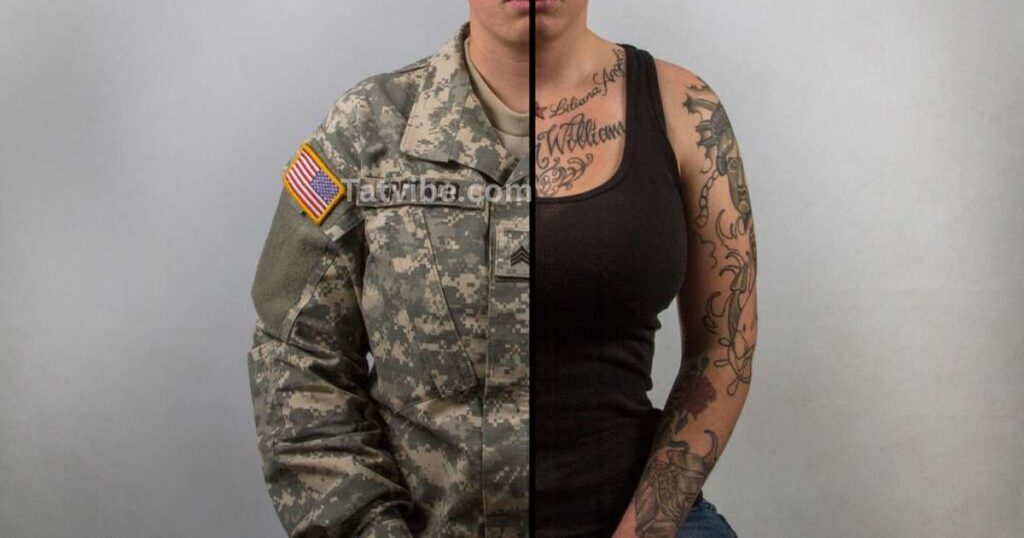Yes, you can have tattoos in the military, but there are specific rules that vary depending on the branch you serve in. Tattoos have become more accepted over the years, but the military still imposes restrictions to maintain professionalism and discipline. This article will explain the general rules, what’s allowed, and what isn’t in different branches of the military.
General Military Tattoo Regulations
Each branch of the military has its own rules regarding tattoos. These rules are in place to ensure that tattoos do not interfere with a soldier’s uniform, mission, or overall professional appearance. While most tattoos are acceptable, certain types, placements, and designs are still prohibited.
Tattoos that are considered offensive, extremist, or sexist are not allowed in any branch of the military. This includes tattoos that promote hate groups, political extremism, or discrimination against any group. Tattoos that are visible on the face, neck, and hands may also be restricted, though this varies by branch.
Tattoos in the Army
The U.S. Army has loosened its tattoo policy in recent years. Soldiers are now allowed to have tattoos on their arms, legs, and hands. However, there are limits on where the tattoos can be located and what they can depict.
- Face and neck tattoos: The Army does not allow tattoos on the face, neck, or head, except for one small tattoo on the back of the neck.
- Hand tattoos: Soldiers can have one visible tattoo on each hand, as long as it doesn’t exceed one inch in length.
- Prohibited tattoos: As in other branches, tattoos that are offensive, gang-related, or extremist are not permitted.
Tattoos in the Navy
The Navy has one of the more lenient tattoo policies among military branches. Sailors are allowed to have visible tattoos, including larger ones, on most parts of the body.
- Neck and hands: Tattoos are allowed on the neck and hands, as long as they meet size restrictions. Tattoos on the neck cannot exceed one inch in any direction, and hand tattoos are limited to a single tattoo no larger than one inch.
- Full sleeves: Sailors are allowed to have full-sleeve tattoos on their arms and legs, as long as the content of the tattoos does not violate the Navy’s policy on offensive or extremist designs.
- Face tattoos: Tattoos on the face are not allowed, except for permanent makeup, such as eyeliner or eyebrow tattoos, which must be conservative.
Tattoos in the Air Force
The Air Force updated its tattoo policy in 2017, relaxing previous restrictions on size and placement. This change made it easier for those with tattoos to join and remain in the service.
- Size restrictions: The Air Force no longer restricts the size or number of tattoos on arms, legs, or other parts of the body, as long as they are not offensive.
- Neck and hand tattoos: Like the Army and Navy, the Air Force allows small tattoos on the neck and hands. One tattoo is allowed on each hand, no larger than one inch in diameter.
- Face tattoos: The Air Force does not allow tattoos on the face, with the exception of cosmetic tattoos.
Tattoos in the Marine Corps
The Marine Corps is known for its strict tattoo policy. While it has relaxed some rules in recent years, it still has one of the most restrictive policies when it comes to tattoos.
- Visible tattoos: Marines can have visible tattoos on their arms and legs, but full sleeves are not allowed. Tattoos must also be at least two inches away from the wrist or elbow.
- Neck, face, and hand tattoos: The Marine Corps prohibits tattoos on the neck, face, and hands, except one small tattoo on each hand.
- Content restrictions: As with other branches, the Marine Corps does not allow tattoos that are offensive or extremist.
Tattoos in the Coast Guard
The Coast Guard follows similar guidelines as the other branches but has its own unique set of regulations for tattoos.
- Neck and face tattoos: The Coast Guard does not allow tattoos on the neck or face, with the exception of permanent cosmetic makeup.
- Hand tattoos: Like other branches, the Coast Guard allows one small tattoo on each hand, no larger than one inch in size.
- Full sleeves: Full-sleeve tattoos are allowed on the arms, but the content must meet the Coast Guard’s standards for professionalism and appearance.
Joining the Military with Existing Tattoos
If you already have tattoos and are thinking about joining the military, it’s important to know that your tattoos will be evaluated during the enlistment process. Each branch will examine your tattoos to ensure they comply with their specific policies. If your tattoos do not meet the standards, you may be asked to remove or modify them before you can join.
Removing or Covering Tattoos
In some cases, military members may choose to remove or cover up tattoos that do not comply with their branch’s policies. Laser tattoo removal is a common option, though it can be costly and time-consuming. In other cases, service members may cover tattoos with clothing or makeup, depending on the tattoo’s size and location.
A Summary
Tattoos are allowed in the military, but each branch has its own rules regarding placement and content. Generally, tattoos that are offensive, extremist, or sexist are not allowed.
While most branches have relaxed their policies in recent years, the Marine Corps still maintains strict regulations. If you are considering joining the military, it’s important to understand your branch’s specific tattoo policies to ensure your tattoos comply with the rules.



